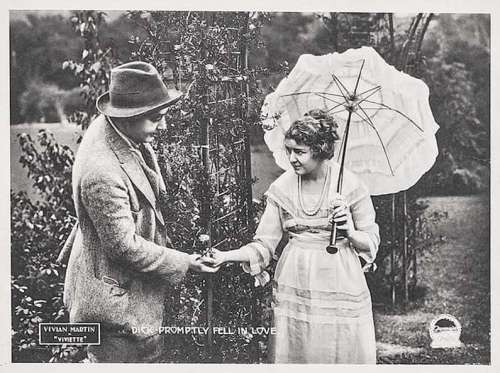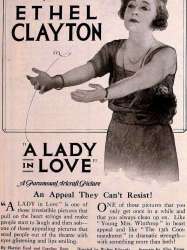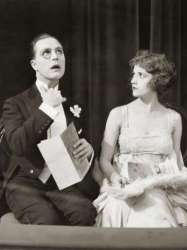Viviette est un film américain réalisé par Walter Edwards avec Vivian Martin
Viviette (1918)

Si vous aimez ce film, faites-le savoir !
- Infos
- Casting
- Infos techniques
- Photos
- Vidéos
- Passages TV
- Citations
- Personnages
- Musique
- Récompenses
Viviette is a 1918 American silent drama film directed by Walter Edwards and written by Julia Crawford Ivers and William J. Locke. The film stars Vivian Martin, Eugene Pallette, Harrison Ford, Kate Toncray, Clara Whipple and Donald Blakemore. The film was released on June 9, 1918, by Paramount Pictures.
Acteurs
Commentaires
Postez un commentaire :
Suggestions de films similaires à Viviette
Il y a 219 films ayant les mêmes acteurs, 24 films avec le même réalisateur, pour avoir au final 70 suggestions de films similaires.Si vous avez aimé Viviette, vous aimerez sûrement les films similaires suivants :

Who Cares? (1919)
, 50minutesRéalisé par Walter Edwards
Origine Etats-Unis
Genres Drame, Comédie, Romance
Acteurs Constance Talmadge, Harrison Ford, Donald MacDonald, Spottiswoode Aitken, Claire Anderson, J. Morris Foster
As described in a film magazine, Joan Ludlow (Talmadge) is living with her grandparents, a grouchy old couple, when a young man, Martin Grey (Ford), moves next door. After the grandparents discover that they have been having secretly meetings for happy and harmless fun, Joan receives such a scolding that she goes over to Martin's and asks him to take her to her friend Alice Palgrave (Randolph), who lives in the city. Upon arrival at the Palgrave residence they discover Alice is not there, and Martin offers to marry Joan to resolve the situation. Pleased with the arrangement, Joan accepts, and after the ceremony they live in Martin's city residence, where he continues to respect her extreme innocence and maidenly existence. Martin spends time at the club while Joan is free to attend several wild parties and conducts what she supposes is an innocent flirtation with Alice's husband Gilbert (MacDonald). Toodles (Anderson), a chorus girl from the club, tempts Martin on his yacht, but he knows how to resist. However, when Joan discovers that Toodles is visiting her husband at the country home, she flirts harder with Gilbert Palgrave. Gilbert, who is suffering from a medical condition ("brain fever"), gets Joan alone one night in a seaside cottage, and threatens to shoot himself unless she consents to his desires. Martin arrives in time to save the day, with Joan discovering her love for Martin and Martin taking her back as his wife.

Young Mrs. Winthrop (1920)
, 50minutesRéalisé par Walter Edwards
Origine Etats-Unis
Genres Drame
Thèmes Adaptation d'une pièce de théâtre
Acteurs Ethel Clayton, Harrison Ford, Helen Dunbar, Joan Marsh, Winifred Greenwood, Charles Ogle

A Lady in Love (1920)
, 50minutesRéalisé par Walter Edwards
Origine Etats-Unis
Acteurs Ethel Clayton, Harrison Ford, Boyd Irwin, Clarence Geldart, Ernest Joy

Good Night, Paul (1918)
Réalisé par Walter Edwards
Origine Etats-Unis
Genres Comédie, Comédie romantique, Romance
Thèmes Adaptation d'une pièce de théâtre
Acteurs Harrison Ford, Constance Talmadge, Harrison Ford, Norman Kerry, Zasu Pitts, Beatrice Van

Easy to Get (1920)
, 50minutesRéalisé par Walter Edwards
Origine Etats-Unis
Genres Comédie
Acteurs Marguerite Clark, Harrison Ford, Rod La Rocque, Julia R. Hurley

Girls (1919)
, 50minutesRéalisé par Walter Edwards
Origine Etats-Unis
Genres Comédie romantique
Thèmes Adaptation d'une pièce de théâtre
Acteurs Marguerite Clark, Helene Chadwick, Harrison Ford, Tom Ricketts, Arthur Edmund Carewe

A Pair of Silk Stockings (1918)
, 1hRéalisé par Walter Edwards
Origine Etats-Unis
Genres Comédie, Comédie romantique, Romance
Thèmes Adaptation d'une pièce de théâtre
Acteurs Constance Talmadge, Harrison Ford, Wanda Hawley, Larry Steers, Sylvia Ashton
Note52%






Passiflore (1918)
, 1h10Réalisé par Walter Edwards
Origine Etats-Unis
Genres Drame
Acteurs Alma Rubens, Francis McDonald, Wheeler Oakman, Frederick Vroom
Felice, une jeune paysanne vivant près de Florence, est si jolie que les villageois l'appellent Passiflore. Jules Mardon, un artiste français en voyage en Italie pour sa santé, fait son portrait et gagne son amour. Toutefois, dès le tableau terminé, il l'abandonne et retourne à Paris, où ce tableau lui apporte la gloire et la richesse. Le riche Armand de Gautier tombe amoureux du portrait, achète le tableau, et part en Italie à la recherche du modèle. Il lui déclare son amour et l'épouse.

Civilisation (1916)
, 1h28Réalisé par Thomas H. Ince, Reginald Barker, Jay Hunt, Raymond B. West, Walter Edwards
Origine Etats-Unis
Genres Drame, Guerre
Thèmes La mer, Religion, Transport, Action sous-marine, Guerre en milieu sous-marin, La bible, Représentation de Jésus Christ
Acteurs Howard C. Hickman, Enid Markey, George Fisher, Lola May, Herschel Mayall, Claire Du Brey
Note58%





Le kaiser déclare la guerre. Son favori, le comte Ferdinand, est nommé commandant d'un sous-marin. Pacifiste, il refuse de tirer sur un paquebot civil censé transporter des munitions pour les ennemis de sa patrie mais il passe malgré tout à l'acte. Blessé, il saborde son sous-marin. Il descend aux Enfers, est sauvé par le Christ réincarné qui lui fait voir ce que les dévastations dues à la guerre peuvent faire. Il devient un pacifiste acharné. Il est arrêté mais libéré par une manifestation de femmes qui imposent la paix.

The Corner (1916)
, 50minutesRéalisé par Walter Edwards
Origine Etats-Unis
Genres Western
Acteurs George Fawcett, Willard Mack, Clara Williams, Charles Miller, John Gilbert
 Connexion
Connexion



